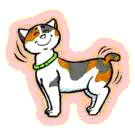Japanese Bobtail Breed Information
HISTORY OF THE BREED
When visiting Japanese shops, you’ll often find a ceramic cat near the front door with a paw raised in welcome. This traditional symbol of welcome and good luck represents the tri-colored Japanese Bobtail (known as the “Maneki-neko”.)
The Japanese Bobtail has existed in Japan for many centuries. It is featured in many ancient stores, art prints and paintings. To this day, it is considered good luck to have one in the house.
In 1968, Elizabeth Freret imported the first three Japanese Bobtails to the United States from Japan. In 1971, they were given provisional standing in the Cat Fanciers Association. In 1976, they were accepted for Championship status.
PERSONALITY PLUS
When you meet your first Japanese Bobtails, you’ll find yourself charmed by their outgoing and loving personalities. They are active, loyal, extremely intelligent, and remain playful even as adults. They are talkative without being noisy, and their soft voices have a large vocabulary of chirps and meows. Many Bobtails like to play in water, and most enjoy a good game of fetch.
Bobtails are good travelers and adjust well to dogs and other animals. They adapt well to most situations and are especially good with children. These traits make the Bobtail an excellent addition to any family.
UNIQUE, ATTRACTIVE APPEARANCE
Japanese Bobtails have long and slender bodies. They are medium-sized, with a firm and muscular body. Adult females generally weigh 5-7 pounds; adult males weight 7-10 pounds.
The Bobtail’s head is triangular. The high, prominent cheekbones accent their large, oval eyes, which are set at a pronounced slant. This gives their faces an oriental appearance. Cats with two different eye colors (odd-eyed) or with blue eyes are considered especially desirable.
COLORFUL, SILKY COATS
Petting a Japanese Bobtail is a pleasure. Their coats are soft and silky, of medium length, and relatively non-shedding. They often start purring immediately–an added bonus!
The Bobtail comes in just about every color, although the color most in demand is the tri-color, good-luck cat which is called “mi-ke” (pronounced “mee-kay”.) Mi-Ke is the Japanese word for “three-furred” (equivalent to our calico coloring). It refers to a predominantly white cat with bright, dramatic patches of red and black. Bicolors (coats of two colors) are also quite popular. Other colors include tabby and whites, dilutes (blue and cream and white), and solids.
In 1993, the Cat Fanciers Association accepted the longhaired variety of Japanese Bobtails for Championship status. Thelonghaired Bobtail has the same overall structure and boning as a shorthair, but with a much longer coat.
THE FAMOUS TAIL
The tail, for which the breed is named, is different from all other breeds. Some tails are rigid; some are not. Some tails can be wiggled; some cannot. The kinks, angles, and curves that make up the tail are as unique to each individual cat as a fingerprint.
Although the tail could be as long as 2-4 inches if it were straightened out, it is most often tightly curved or kinked. The hair is slightly longer than on the rest of the body, creating a variety of appearances from a shaving brush look to a pom-pom.
ROBUST AND HARDY
Japanese Bobtails are sturdy, tough little cats. Compared to other breeds, they are active earlier as kittens, have a lower kitten mortality rate, and do not seem to be prone to any specific genetic problems as are some breeds.
The Manx and Japanese Bobtail are not related in any way. Not only are their body and head types completely different, the genetic factor that creates the Japanese Bobtail is also completely different from the one that makes the Manx cat. Unlike the Manx, the Bobtail gene breeds true with no related birth defects
ABOUT KIDDLYN KATTERY
Kiddlyn Kattery was established in 1974 and is a CFA Approved Cattery of Excellence. We breed selectively for type and temperament. Our kittens are home-raised to nurture outgoing and loving personalities. We guarantee the health and disposition of our cats and kittens. (See The Kattery, Contracts and Guarantees Sections for more information.)
We do not place our babies in homes where they will be allowed to roam outdoors, nor in homes where they will be declawed.
Our kitten prices range from $1000-$1500 (plus shipping costs). Our “retired” show cats start at $450.
